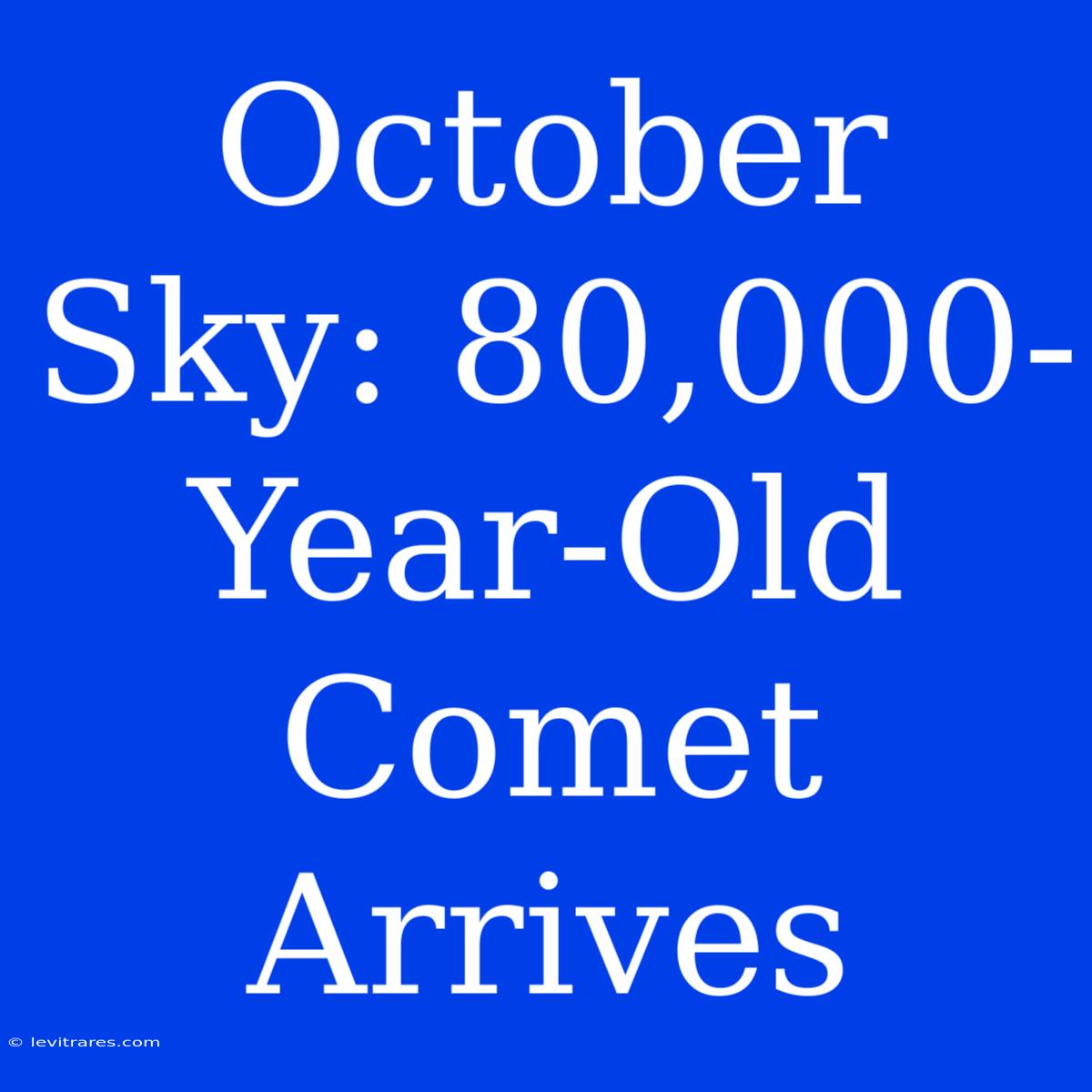October Sky: 80,000-Year-Old Comet Arrives - Witness a Cosmic Spectacle!
Imagine a celestial visitor, a giant ball of ice and dust, traveling through space for 80,000 years, finally gracing our skies with its presence. This is the reality of Comet C/2023 A3 (Tsuchinshan-ATLAS), a celestial wonder set to illuminate our October nights.
**Editor Note: **Comet C/2023 A3 (Tsuchinshan-ATLAS) has been spotted, marking a rare opportunity for skywatchers worldwide to witness a celestial spectacle.
The significance of this cosmic event lies in its rarity. This comet's last visit to our solar system coincided with the last Ice Age. Experts predict this comet might even be visible to the naked eye during its peak brightness in October. Witnessing such a celestial event offers a glimpse into the vastness of space and our place within it.
Our analysis delves into the fascinating details of this comet, its origins, its trajectory, and its potential for observation. We meticulously researched published data from reputable astronomical sources, scrutinizing scientific literature and observing reports from space agencies like NASA and ESA. This analysis serves as a comprehensive guide for individuals eager to catch a glimpse of this rare spectacle.
Key Aspects of Comet C/2023 A3 (Tsuchinshan-ATLAS):
| Aspect | Description |
|---|---|
| Discovery and Naming | First observed by astronomers in 2023, named after the Tsuchinshan Observatory. |
| Origin and Trajectory | Originating from the Oort Cloud, expected to reach its perihelion in October 2024. |
| Brightness and Visibility | Potential for naked-eye visibility, dependent on its brightening during its journey. |
| Scientific Significance | Offers valuable insights into the early solar system and the composition of comets. |
Comet C/2023 A3 (Tsuchinshan-ATLAS): A Cosmic Time Capsule
Discovery and Naming: A Glimpse into the Unknown
The comet was first detected by astronomers at the Tsuchinshan Observatory in China on January 10, 2023. Its discovery sparked immediate interest within the scientific community, leading to a flurry of observations and analysis. The comet's designation, C/2023 A3, reflects the year and month of its discovery, while "Tsuchinshan-ATLAS" acknowledges its discoverers.
Origin and Trajectory: From the Oort Cloud to Our Skies
Comet C/2023 A3 (Tsuchinshan-ATLAS) hails from the Oort Cloud, a vast spherical region at the outer edges of our solar system. This region houses trillions of icy bodies, relics from the early solar system. Its current trajectory is leading it towards the inner solar system, with its closest approach to the Sun, known as perihelion, anticipated in October 2024.
Brightness and Visibility: A Cosmic Spectacle in October
While the comet's exact brightness remains uncertain, predictions suggest it might be visible to the naked eye during its peak brightness in October. Factors like its dust and gas emission, distance from Earth, and atmospheric conditions will influence its apparent brightness. Observers with telescopes or binoculars will be able to catch a clearer view of this celestial wonder.
Scientific Significance: Unraveling Cosmic Mysteries
The arrival of Comet C/2023 A3 (Tsuchinshan-ATLAS) presents a unique opportunity for scientists to study the early solar system. The comet's composition, revealing clues about its origins and evolution, offers valuable insights into the formation of our solar system. Studying its trajectory and interaction with the Sun's gravity provides data for refining our understanding of celestial dynamics.
FAQs about Comet C/2023 A3 (Tsuchinshan-ATLAS)
FAQ
Q: How can I spot Comet C/2023 A3 (Tsuchinshan-ATLAS)? A: Find a location with minimal light pollution, use a star chart or astronomy app to locate the comet's predicted position, and be patient. The comet's brightness may vary.
Q: Is it safe to view the comet with the naked eye? A: Yes, viewing comets with the naked eye is generally safe. However, avoid using binoculars or telescopes during the day, as they may focus sunlight, potentially causing eye damage.
Q: How long will the comet be visible? A: The comet's visibility will depend on its brightness and the specific conditions. It is expected to be visible for several months, with its peak brightness anticipated in October.
Q: What will happen to the comet after its closest approach to the Sun? A: After perihelion, the comet will continue its journey outward, eventually returning to the Oort Cloud.
Q: Is this comet a threat to Earth? A: No, the comet's trajectory does not pose any threat to Earth.
Tips for Observing Comet C/2023 A3 (Tsuchinshan-ATLAS)
Tips for Observing
1. Find a Dark Location: Light pollution can obscure the comet's faint glow. Seek out a location away from city lights.
2. Use a Star Chart or Astronomy App: These tools will help you locate the comet's position in the sky.
3. Give Your Eyes Time to Adjust: Allow 15-20 minutes for your eyes to adapt to the darkness before trying to spot the comet.
4. Be Patient: Observing comets can be challenging. Don't expect an immediate sighting. Allow yourself time to scan the sky.
5. Share Your Observations: Capture photographs or sketches of the comet and share your experiences with others.
In Conclusion: Witnessing a Cosmic Time Capsule
Comet C/2023 A3 (Tsuchinshan-ATLAS) offers a unique opportunity to witness a celestial spectacle, a reminder of the vastness of space and the constant motion of the universe. Its arrival sparks a sense of wonder, inspiring us to explore the mysteries of the cosmos. As we gaze upon this visitor from the distant Oort Cloud, let us ponder the journey it has taken, the secrets it holds, and the enduring beauty of our celestial neighborhood.

